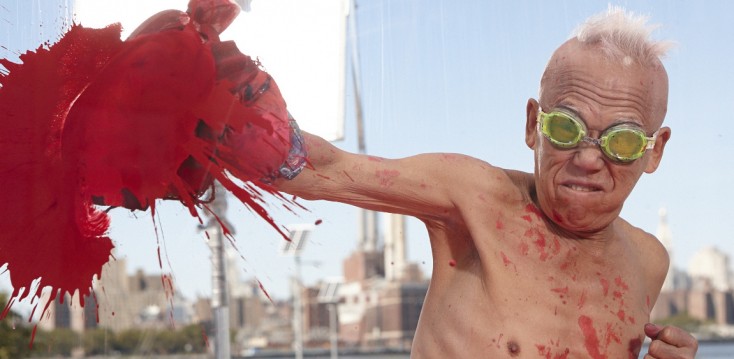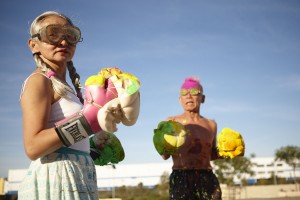By ANGELA DAWSON
Front Row Features
HOLLYWOOD— The life and career of an octogenarian Japanese avant-garde artist émigré living in New York City with his much younger wife are the subject of “Cutie and the Boxer,” a documentary by filmmaker Zachary Heinzerling.
Cutie is Noriko Shinohara, wife of artist Ushio Shinohara, a Neo-Dadaist who has become internationally known for his trademark boxing paintings. (Ushio literally punches the canvas with boxing gloves dipped in paint and in the span of 2.5 minutes and creates a unique, colorful work of art.) Now in his early 80s, Ushio has had his paintings and sculptures exhibited in prestigious galleries and art museums throughout the world, including the Hara Museum of Contemporary Art in Japan, the Guggenheim museum in New York, the Museum of Contemporary Art in Los Angeles as well as the Atelier & Galerie oko Galerie in Berlin. Noriko, in her early 60s, is a painter and ink sketch artist, whose work has been exhibited at hpgrp Gallery in New York and elsewhere. Neither has achieved financial success. They live in a small, cramped apartment in Brooklyn, which is near their respective studios.
What emerges in “Cutie and the Boxer” is a portrait of a marriage between artists, one of whom had achieved a degree of fame over the years, while the other has felt somewhat overlooked both as a mate and as an artist in her own right. The camera follows them as they go about their daily activities, from the mundane (brushing their teeth, preparing and eating meals) to painting and getting ready for an important exhibition. The documentary, which has been nominated for an Oscar, is available Tuesday, Feb. 4 on DVD.
Ushio is no stranger to documentary filmmaking. He was the subject of a short documentary 40 years ago called “Shinohara: The Last Artist,” by Rod McCall. (That short film is a special feature on the “Cutie and the Boxer” DVD.)
Heinzerling followed the couple around with his camera for five years, and what emerged is a captivating portrait about creativity, sacrifice and, ultimately, a love story.
The couple recently spoke by phone about the much-acclaimed film and working with the young filmmaker. (Director Heinzerling won the Sundance director’s award in 2013 for the documentary and he also was a nominee this year for the Directors Guild of America award in the documentary category.) “Cutie and the Boxer” is one of five feature-length documentaries nominated for an Academy Award this year.
Q: Congratulations on the Oscar nomination. How did you hear the film had been nominated?
Noriko: We were sleeping and somebody called us from Japan. That’s how I knew.
Ushio: I asked, “Why are you saying congratulations?” Then, we found out about the nomination.
Q: It must have been an amazing year from Sundance in 2013 through now. Has the release of the film changed your lives in some way?
Noriko: We feel like everyone all over the world is becoming our friends.
Ushio: Usually, at the subway or at a restaurant, everybody who sees us says “Congratulations!” I’m a painter. I exhibit my paintings in an art gallery in our neighborhood. So I’m very happy.
Q: Has this film helped increased awareness of your work? Have people been interested in buying or exhibiting your work?
Ushio: The buying and exhibiting communities are very different. Being famous is completely different from the American Dream. I’m famous but not rich.
Noriko: I’ve sold some works because of the film. I think more things will happen, I believe.
Q: Ushio, you were the subject of another documentary 40 years ago, so you were used to being followed around by a camera. How was this experience different for you? What did you think of the finished film?
Ushio: To compare being followed around for the other documentary, the filming of this film—the experience—was pretty much the same. But when I saw the finished film, I was actually surprised. This movie, which is 90 minutes long, surprised me to see that it turned out to be a love story. The movie didn’t show the side of me that is very very talented. Being in the film is different from getting recognition in the art world, which is a very happy experience for me. If I’m in the subway, people would recognize me and would talk to me, and that makes me happy. So learning from this experience, I’d like to make artwork that more directly expresses than the film. By being involved in film, I have been influenced by what I’m planning to do in the future for the art.
Q: Ushio, what advice would you give to young artists?
Ushio: I’m concentrating on what the young people are making. First of all, I don’t think of myself as an old school guy, as an old person. And I regard young artists as rivals, the enemy. Young people tend to have fresh ideas and energy. That’s making me envious and jealous, especially when I see young people climbing up the subway staircase without any effort. That really really gets me angry. I see myself in the same position as young people in this competition so I have no particular advice for them.
Q: You’re still learning?
Ushio: Learning is something I’m intending to do throughout my life.
Q: Noriko, when you saw this film, there appears to be a lot of pent up feelings about equality and being respected alongside Ushio. After watching this, and seeing your exhibit together, do you feel you’ve received respect as an artist and as a wife?
Noriko: As a wife and in my life, (Ushio) has never changed. He’s Japanese old school. But nowadays people see my work as more important, so I’m very glad about it. The last part of the film (where the couple playfully boxes with the paint on the gloves) is my favorite part because it shows that I’ve had this long, struggling life and then all of a sudden, it changes the color and the feeling. And I’m boxing him.
Q: After you finished your sketch series of “Cutie and Bullie,” (inspired by your life with Ushio) have you continued that or have you taken a new direction in your art?
Noriko: Right now I’ve got an exhibition in Tokyo, which continues “Cutie and Bullie.” But I’m doing painting for a long time, and also pastels and etching. So I’m doing other media other than ink sketch. I’m doing pastels, oil paintings. I have to continue that. I finished my story for the comic book, so I’m waiting for the publisher now. If I can publish my book, I want to make an entire animation for “Cutie and Bullie.” I’m hoping that’s going to happen.
Q: In the film, we see your son Alex, who also is an artist. Is he continuing to paint and exhibit?
Noriko: Yes. He’s excited to continue his work. These days he has more ideas and he’s working more.
Q: You’ve gotten to know Zach (the director) very well in the past five years. Do you feel like family now?
Noriko: Zach could always observe us clearly. He became so close that it became natural for us (to have him around).
Q: Ushio, in the film, a woman from the Guggenheim tells you she may be interested in purchasing one of your pieces. Did she ever call back?
Ushio: Not yet. They are so tight. (He chuckles.)
Noriko: Not tight. Because usually museums take a long time to decide. When he had another painting at the National Gallery of Osaka, it was 1991, and they bought it nine years later. Dealing with museums is different from dealing with private collectors.
Q: We see in the film that money is often tight for you. Financially, do you feel more on stable ground?
Noriko: Yeah. At the end of last year, one of the pieces sold so it was better than 2012. But this year, we don’t know yet.
Ushio: As long as I can keep my studio and have enough material to make art, that’s pretty much all I need. My lifestyle is that I live by the week so as long as that week is secure I’m good. The longest I can plan is for two or three months ahead and after that, I don’t know what’s going to happen.
Q: Are you flying here to Hollywood to attend the Oscars?
Ushio and Noriko: Yes!
Q: Noriko, do you have your gown ready?
Noriko: That’s the problem. Remember the royal wedding in England? The gown (Kate Middleton) wore was a secret. So I have to be like that.






